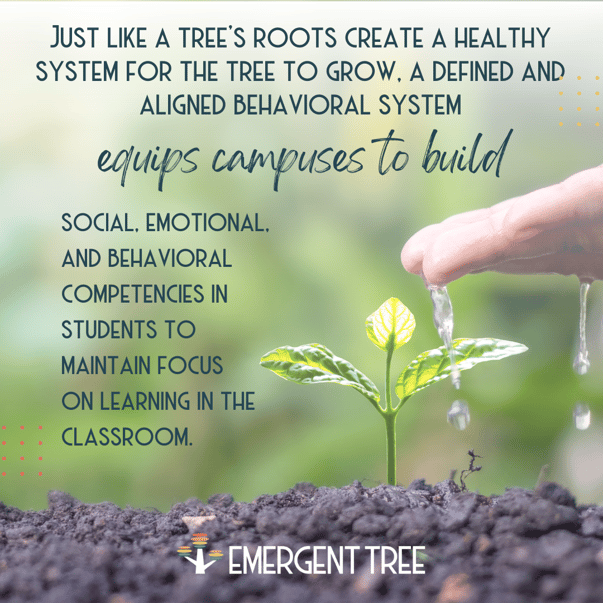A Strong Root System: Alignment for all Tiers
I get the amazing opportunity to work with district leaders, teachers, and students daily, supporting their MTSS-Behavior frameworks. One thing I often have teams do when we first start working together is to draw a tree. Yes, it’s art class time! I’ve seen many creative trees from different perspectives, including colorful fruit, detailed leaves and branches, adorable woodland creatures, and bird nests. No tree is the same, which is part of the fun part of this activity.
What I’ve found interesting is that I rarely see the tree's roots drawn. The roots are the core of what brings the tree to life, and an unhealthy root system impacts all other parts of the tree. The tree visual is so important to us at Emergent Tree that, as you can see, it’s a part of our name.
Just like a tree's roots create a healthy system for the tree to grow, a defined and aligned behavioral system equips campuses to build social, emotional, and behavioral competencies in students to maintain focus on learning in the classroom.

So, what is a healthy behavioral system?
We’re all familiar with the phrase, “An apple a day keeps the doctor away.” And, I’m sure we’re all aware that an apple alone likely won’t actually keep the doctor away, but the logic in this phrase is helping you look at balance and embed nutrition into your diet to stay healthy. As campus leaders and teachers, we want our students to be strong and healthy. In general, we all know that the healthier we are, the easier it is for us to combat illness or challenges that come our way. We are likelier to feel run down or get sick if we don't care for ourselves. Looking at this through the behavior lens, if we do not create environments for students that support their social, emotional, and behavioral wellness, they are more likely to display unhealthy, dysregulated, and undesired school behaviors.
If we translate the healthy diet visual through a behavior lens, here are the core elements we’ve come up with that need to be incorporated into a student’s “behavior supports tray.”
- Skill Building
- Acknowledge
- Correction
- System Support
- Connections
- Data Informed

The American Psychological Association defines standards of practice as "a set of guidelines that delineate the expected techniques and procedures, and the order in which to use them, for interventions with individuals... to ensure that practitioners use the most well researched and validated treatment plans available in their fields." Like other professions, campuses should define their standards of practice for behavior supports in the classroom and individual intervention, using the tray framework as a guide. This approach allows school districts to define standards of practice across the entire organization (tray components) - while leaving space for differing preferences from campus to campus (tray practices). By aligning behavior supports across classrooms, we increase the likelihood that all students have equitable and reliable access to evidence-based supports for behavior.
These guiding tray elements apply to all tiers within a multi-tiered system.
When you start to feel like you might be getting sick, you add extra vitamins into the mix, get more rest, and begin being more careful with washing your hands, etc., right? The same is the case as we navigate the multi-tiered system. As different student needs arise, you might increase supports to address the need - but the additional supports stay aligned to tray components.
With a foundation at Tier 1 that flows into Tier 2 and Tier 3, there is always a clear next step when the current strategies are not resulting in expected or desired progress. If Tier 1 strategies are strong, but a student still needs additional support - campuses apply the tray components at Tier 2. And if the behavior persists, even more intense supports are defined and aligned into a Tier 3 tray. An aligned multi-tiered framework provides clarity and guidance for all staff about expected supports and interventions at each tier, how to measure fidelity at each tier, and the steps to move to higher supports (or fade down to more independence) at the next tier. It allows all staff to speak a common language no matter what grade level or tier of support a student receives.

Why is a system like this important?
Building a multi-tiered system at your school is no small feat. Your campus is unique. Each grade level is different. Each teacher has varied preferences, personalities, and pre-existing practices in their classroom. And on top of that, every student has their unique background and needs. A common, unified approach at all tiers and grade levels provides consistency in navigating each classroom's diverse needs and preferences. Student skills scaffold on top of each other year-to-year as they advance. Parents have more clarity and access to school functioning. Teachers have clarity on expected practices. Districts find unity across the tier components with space for flexibility in specific practices from campus to campus.
Often, behavior can feel like a moving target, and teachers can feel unsure of what practices to follow. Building an aligned framework, starting at Tier 1, will help everyone feel confident with their approach to a multi-tiered system for behavior.
Advice for the road?
Think about the current practice supporting behavior on your campus. Is there a common set of behavioral expectations shared across all teachers? Do you have aligned practices applied by all teachers that you could observe and measure? If so, what tray component do these practices connect to? This is the first step to articulating your classroom standards of practice into an MTSS Framework! If you still need to, you know your first step. Use the tray framework to guide and align practices in whatever implementation phase you are currently in. You got this!
Looking for some additional resources for your journey?
- Check out an overview video about the Behavior Tray of Supports.
- Course: The Check-In Check-Out Intervention for Schools
- Course: Feedback with the Daily Behavior Report Card (DBRC) Intervention



Comments